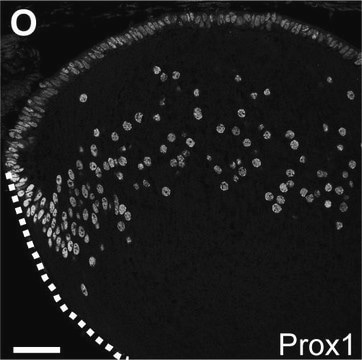Good at showing doublet bands for the AQP4 isoforms by Western blot, 1:1000 goes a long way. Fair bit of non-specific binding at higher molecular weights which originally messed with the chemiluminescence signal when I was optimising, but this became moot when I stated cutting the membrane to load beta-actin and AQP4 antibodies seperately (at the same time). Would not reccomend trying 1:2000 primary or using NFM to block/dilute, not sure how good it is on PVDF membranes but worked well on my nitorcellulose.
AB3594
Anti-Aquaporin-4 Antibody
CHEMICON®, rabbit polyclonal
Sinonimo/i:
Mercurial-Insensitive Water Channel
Scegli un formato
Scegli un formato
About This Item
Prodotti consigliati
Nome del prodotto
Anti-Aquaporin 4 Antibody, CT, Chemicon®, from rabbit
Origine biologica
rabbit
Livello qualitativo
Forma dell’anticorpo
affinity isolated antibody
Tipo di anticorpo
primary antibodies
Clone
polyclonal
Reattività contro le specie
mouse, human, rat
Produttore/marchio commerciale
Chemicon®
tecniche
immunohistochemistry: suitable
western blot: suitable
N° accesso NCBI
N° accesso UniProt
Condizioni di spedizione
wet ice
modifica post-traduzionali bersaglio
unmodified
Informazioni sul gene
human ... AQP4(361)
Descrizione generale
Specificità
Immunogeno
Applicazioni
A previous lot of this antibody was used on rat brain sections.
Dilutions should be made using a carrier protein such as BSA (1-3%).
Western blotting:
1:500-1:1,000 using ECL on rat brain membranes.
Optimal working dilutions must be determined by the end user
Neuroscience
Ion & Transport Channels
Qualità
Western Blot Analysis: 1:500 dilution of this lot detected AQUAPORIN 4 on 10 μg of Mouse Brain lysates.
Descrizione del bersaglio
Stato fisico
Stoccaggio e stabilità
Risultati analitici
Clear vial of RbX Aquaporin 4, CT Control Antigen(AB3594-50ULb) included free of charge with the antibody is 120 µg of control antigen (lyophilized powder). Reconstitute with 100 µL of PBS. For positive control, in Western blot use 20 ng of protein per Minigel lane. For negative control, preincubate 3 µg of purified peptide with 1 µg of antibody for one hour at room temperature. Optimal concentrations must be determined by the end user.
Altre note
Note legali
Esclusione di responsabilità
Non trovi il prodotto giusto?
Prova il nostro Motore di ricerca dei prodotti.
Classe di pericolosità dell'acqua (WGK)
WGK 2
Punto d’infiammabilità (°F)
Not applicable
Punto d’infiammabilità (°C)
Not applicable
Certificati d'analisi (COA)
Cerca il Certificati d'analisi (COA) digitando il numero di lotto/batch corrispondente. I numeri di lotto o di batch sono stampati sull'etichetta dei prodotti dopo la parola ‘Lotto’ o ‘Batch’.
Possiedi già questo prodotto?
I documenti relativi ai prodotti acquistati recentemente sono disponibili nell’Archivio dei documenti.
Active Filters
Il team dei nostri ricercatori vanta grande esperienza in tutte le aree della ricerca quali Life Science, scienza dei materiali, sintesi chimica, cromatografia, discipline analitiche, ecc..
Contatta l'Assistenza Tecnica.










